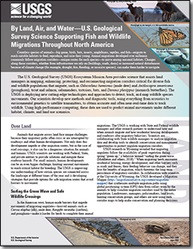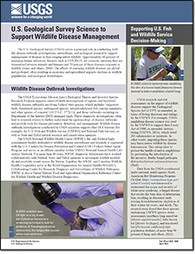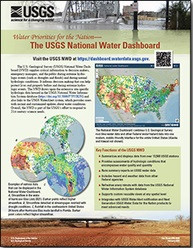
Product Details
- Product Number
- 534152
- Series
- FS-2022-3030
- Scale
- NO SCALE
- Alternate ID
- FS-2022-3030
- Authors
- DAVID HU
- Version Date
- 06/01/2022
- Countries
- USA
- Media
- WEB ONLY
- Format
- WEB ONLY
Additional Details
- Description
-
By Land, Air, and Water—U.S. Geological Survey Science Supporting Fish and Wildlife Migrations Throughout North America
This product is not available for order, it can only be downloaded from here (click on image) or within the Publications Warehouse at https://pubs.er.usgs.gov/publication/fs20223030
First posted June 22, 2022
For additional information, contact:
Associate Director, Ecosystems Mission Area https://www.usgs.gov/mission-areas/ecosystems U.S. Geological Survey 12201 Sunrise Valley Drive Reston, VA 20192
Abstract
Countless species of animals—big game, birds, bats, insects, amphibians, reptiles, and fish—migrate to reach suitable habitats to feed, reproduce, and raise their young. Animal migrations developed over millennia commonly follow migration corridors—unique routes for each species—to move among seasonal habitats. Changes along those corridors, whether from human development (buildings, roads, dams) or from natural disturbances (for example, climate change, drought, fire, flooding, or invasive species), can make them harder to navigate. The U.S. Geological Survey’s Ecosystems Mission Area provides science that assists land managers in mapping, enhancing, protecting, and reconnecting migration corridors critical for diverse fish and wildlife populations that migrate, such as Odocoileus hemionus (mule deer) and and Antilocapra americana (pronghorn), trout and salmon, salamanders, tortoises, bats, and Danaus plexippus (monarch butterflies).
- Survey Date
- 2022
- Print Date
- 2022
- Height In Inches
- 11.000
- Length In Inches
- 8.500
- Languages
- English





